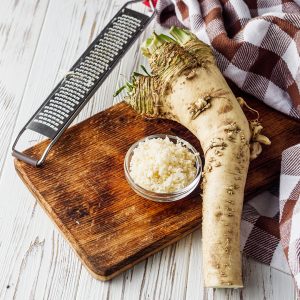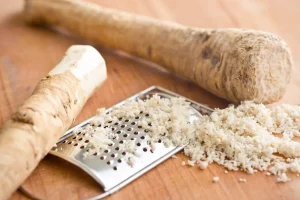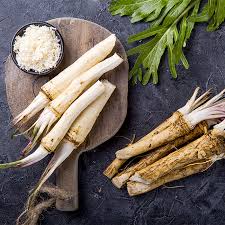
ADVANTAGES OF HORSERADISH
Advantages of Horseradish. The mustard family includes the peppery root vegetable horseradish. Colder climates are ideal for growing this vegetable, which is seeded in early spring or late fall. Horseradish is frequently used to season everything from fish to burgers and is often manufactured into a readymade sauce of the same name.
ADVANTAGES OF HORSERADISH
However, it tastes a lot like wasabi, which is a popular sushi garnish. The pungent, sharp flavor of horseradish makes it stand out from other vegetables. Horseradish sauce is produced by combining vinegar and shredded or pureed horseradish root with sour cream, radish or mayonnaise.
1. cuts down on inflammation

Also, a substance known as sinigrin is present in horseradish, just like in other plants in the mustard family. The immune system components that induce inflammation are blocked or altered by sinigrin, according to research. The same findings imply that sinigrin may alleviate atherosclerotic symptoms, but further research is necessary before any firm conclusions can be made.
2. protects against cell damage
Meanwhile, orseradish root is naturally rich in antioxidants, which can help protect your body from cellular harm by attaching themselves to free radicals. Additionally, preliminary study indicates that horseradish may inhibit the formation of stomach, lung, and colon cancer cells; nevertheless, more human studies are required by researchers and medical professionals.
3. antimicrobial qualities

According to early study, the phytochemical isothiocyanates found in horseradish may be able to eliminate the bacteria and fungi that cause food poisoning, stomach ulcers, and skin and nail fungus.
4. Assists with Digestion

Horseradish has a delicious flavor and aids in a healthy digestive system. For example, it supports the function of the liver. Horseradish belongs to a class of foods known as cholagogues because it causes the gallbladder to release bile, which is an essential part of digestion and keeps your entire body functioning properly.
5. Diuretic Properties
Also, because of its diuretic qualities, horseradish encourages urination. This is crucial for maintaining the cleanliness of your liver and for routinely eliminating toxins from your body.
6. Aid for Weight Loss

Meanwhile, horseradish is a safe addition to dishes because it is high in fiber and low in calories. Horseradish is therefore the solution if you want to add flavor without increasing your calorie intake. We enjoy adding it to sauces and salad dressings to enhance their flavor and cut down on the quantity of dressing or sauce required.
7. Inherently antimicrobial
However, according to studies, allyl isothiocyanate, an antibacterial component of horseradish, is present. This has been demonstrated in recent research to eradicate pathogenic bacteria and microorganisms that cause diseases. Additionally, horseradish may be useful in the treatment of UTIs. This is as a result of its dual diuretic and antibacterial qualities.
8. Increases Blood Flow and Eliminates Mucus

Although, horseradish may be your best buddy if you have a cold or sinus infection. Its high sulfur content has been demonstrated to aid in mucus removal and nasal channel clearing. Horseradish’s biocompounds can also encourage drainage and help with face circulation.
Summary
The root vegetable horseradish is well-known for its strong taste and smell. Its constituents may offer a range of health advantages, including the prevention of infections, cancer, and respiratory disorders. The most common way to eat horseradish is as a condiment. The ideal way to take supplements is under a doctor’s supervision.